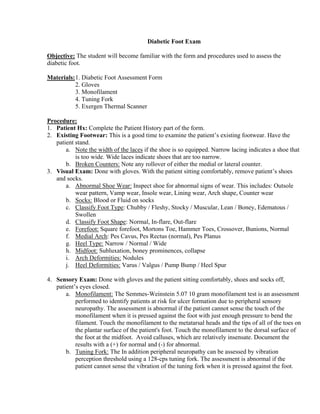
Diabetic Foot
- 1. Diabetic Foot Exam Objective: The student will become familiar with the form and procedures used to assess the diabetic foot. Materials: 1. Diabetic Foot Assessment Form 2. Gloves 3. Monofilament 4. Tuning Fork 5. Exergen Thermal Scanner Procedure: 1. Patient Hx: Complete the Patient History part of the form. 2. Existing Footwear: This is a good time to examine the patient’s existing footwear. Have the patient stand. a. Note the width of the laces if the shoe is so equipped. Narrow lacing indicates a shoe that is too wide. Wide laces indicate shoes that are too narrow. b. Broken Counters: Note any rollover of either the medial or lateral counter. 3. Visual Exam: Done with gloves. With the patient sitting comfortably, remove patient’s shoes and socks. a. Abnormal Shoe Wear: Inspect shoe for abnormal signs of wear. This includes: Outsole wear pattern, Vamp wear, Insole wear, Lining wear, Arch shape, Counter wear b. Socks: Blood or Fluid on socks c. Classify Foot Type: Chubby / Fleshy, Stocky / Muscular, Lean / Boney, Edematous / Swollen d. Classify Foot Shape: Normal, In-flare, Out-flare e. Forefoot: Square forefoot, Mortons Toe, Hammer Toes, Crossover, Bunions, Normal f. Medial Arch: Pes Cavus, Pes Rectus (normal), Pes Planus g. Heel Type: Narrow / Normal / Wide h. Midfoot: Subluxation, boney prominences, collapse i. Arch Deformities: Nodules j. Heel Deformities: Varus / Valgus / Pump Bump / Heel Spur 4. Sensory Exam: Done with gloves and the patient sitting comfortably, shoes and socks off, patient’s eyes closed. a. Monofilament: The Semmes-Weinstein 5.07 10 gram monofilament test is an assessment performed to identify patients at risk for ulcer formation due to peripheral sensory neuropathy. The assessment is abnormal if the patient cannot sense the touch of the monofilament when it is pressed against the foot with just enough pressure to bend the filament. Touch the monofilament to the metatarsal heads and the tips of all of the toes on the plantar surface of the patient's foot. Touch the monofilament to the dorsal surface of the foot at the midfoot. Avoid calluses, which are relatively insensate. Document the results with a (+) for normal and (-) for abnormal. b. Tuning Fork: The In addition peripheral neuropathy can be assessed by vibration perception threshold using a 128-cps tuning fork. The assessment is abnormal if the patient cannot sense the vibration of the tuning fork when it is pressed against the foot.
- 2. Touch the tuning fork to the metatarsal heads and the tips of all of the toes on the plantar surface of the patient's foot. Touch the tuning fork to the dorsal surface of the foot at the midfoot. Avoid calluses, which are relatively insensate. Document the results with a (+) for normal and (-) for abnormal. 5. Thermal Exam: Taking temperature readings on both the plantar and dorsal surfaces of the foot may be a good indicator of foot condition. A wide difference of temperatures between left and right feet can indicate possible infection, injury or circulatory problems. Done with gloves and the patient sitting comfortably, shoes and socks off. a. Dorsal Temp: Take a reading on the dorsum of the foot near the dorsalis pedis artery. b. Plantar Temp: Take a reading on the plantar aspect of the foot in the medial arch area. 6. Skin & Nail Exam: Done with gloves and the patient sitting comfortably, shoes and socks off. a. Corns & Calluses: Metatarsal heads, Dorsal aspect of 5th toe, Lateral aspect of 1st toe, Heel, Plantar surface b. Skin appearance: Shiny, thin, fragile c. Hair: Normal hair growth / no hair growth d. Skin Features: Bruises, Cracks/breaks in skin, Soggy skin, Dry skin, Blisters, Discoloration, Ulcerations, Previous surgeries, Tinea Pedis (Fungus) e. Nails: Ingrown, Improperly cut, Sharp, Long, Absent, Fungus 7. Pedal Pulses: Pedal pulses are assessed by Palpation of the dorsalis pedis artery pulse and Palpation of the posterior tibial pulse. Absence or presence of pedal pulses should be documented. Done with gloves and the patient sitting comfortably, shoes and socks off. a. Dorsalis Pedis Pulse: Palpated with three fingers in the depression between the first and second rays at the instep. b. Posterior Tibial Artery: Palpated with three fingers in the depression between the Achilles tendon and the tibia on the medial side.